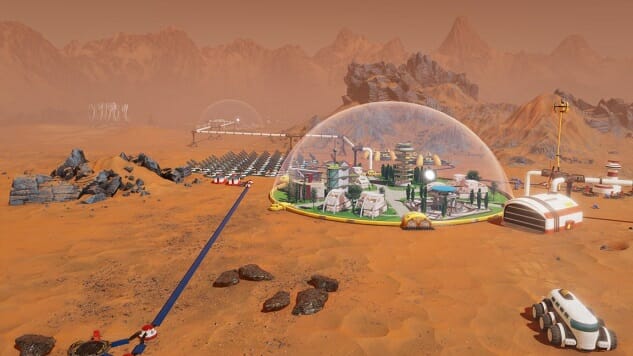Surviving Mars Is a City Builder With Too Much Strategy

I’ve been surprised by Surviving Mars. You play as the grand organizer of a Martian colony. People are leaving Earth for various reasons, and you’ve gotta get a working planet going for them all the way out on Mars. You start constructing things and discovering the surface of the world with your robots and, eventually, you bring human beings to live in giant domes filled with houses, industrial buildings, and all of the other things that you might expect from a city builder game. I expected to love it. I don’t. I can’t figure out why.
One reason might be that the game has very little interest in giving you any sort of tutorial. On the game’s main menu there is a button to click that takes you to a YouTube video, but beyond that you are on your own. Starting a game means being dumped, unceremoniously, onto the surface of the planet. Sometimes you get a tooltip that tells you what you might want to do next, but that’s it. It is, in a word, confusing.
Maybe my expectations were wrong. I thought that Surviving Mars would be something akin to Cities: Skylines, the wonderful city builder experience that plops you down on a patch of dirt and asks you to build a city. In that game, you manage water, power and cash flow, and as long as your citizens have the first two and you have enough of the last one, everything works out great. Surviving Mars is different because there are explicit goals that make it feel more deterministic at every stage.
The opening of the game, for example, has you gathering resources with robots in preparation for bringing humans to the planet. There’s only so much that you can do in this part of the game, and it’s clearly only a preparatory phase. And it’s frustrating, to some degree, because it’s not as if the game ever really radically changes during this part of the game. You gather concrete. You put down oxygen, water and power lines to make domes habitable for colonists. And you make your way to the next phase.
This puts Surviving Mars in the uncomfortable place of being somewhere between a strategy game and a city builder. There seems to be a clear set of optimal ways of playing the game that make for the best possible colony. That’s the strategy element. And there is also a wide range of freedom within those general optimal methods, and that’s where the city builder elements kick in. In the same way that I can place neighborhoods in Cities: Skylines, I can organize my giant habitat domes in various ways around the surface of Mars to impact how, when, and under what conditions my colonists can interact with and between them.
-

-

-

-

-

-

-

-

-

-

-

-

-

-

-

-

-

-

-

-

-

-

-

-

-

-

-

-

-

-

-

-

-

-

-

-

-

-

-

-









































